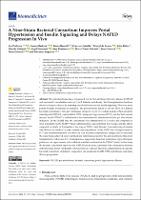| dc.contributor | Vall d'Hebron Barcelona Hospital Campus |
| dc.contributor.author | Pinheiro, Iris |
| dc.contributor.author | Barbera Belles, Aurora |
| dc.contributor.author | Raurell Saborit, Immaculada |
| dc.contributor.author | Estrella Gonzalez, Federico |
| dc.contributor.author | de Leeuw, Marcel |
| dc.contributor.author | Bolca, Selin |
| dc.contributor.author | Salcedo Allende, Maria Teresa |
| dc.contributor.author | Genescà Ferrer, Joan |
| dc.contributor.author | Martell Pérez-Alcalde, María |
| dc.contributor.author | Augustin Recio, Salvador |
| dc.date.accessioned | 2022-09-09T08:29:39Z |
| dc.date.available | 2022-09-09T08:29:39Z |
| dc.date.issued | 2022-05-20 |
| dc.identifier.citation | Pinheiro I, Barberá A, Raurell I, Estrella F, de Leeuw M, Bolca S, et al. A Nine-Strain Bacterial Consortium Improves Portal Hypertension and Insulin Signaling and Delays NAFLD Progression In Vivo. Biomedicines. 2022 May 20;10(5):1191. |
| dc.identifier.issn | 2227-9059 |
| dc.identifier.uri | https://hdl.handle.net/11351/8097 |
| dc.description | Bacterial consortium; Gut microbiome; Portal hypertension |
| dc.description.abstract | The gut microbiome has a recognized role in Non-alcoholic fatty liver disease (NAFLD) and associated comorbidities such as Type-2 diabetes and obesity. Stool transplantation has been shown to improve disease by restoring endothelial function and insulin signaling. However, more patient-friendly treatments are required. The present study aimed to test the effect of a defined bacterial consortium of nine gut commensal strains in two in vivo rodent models of Non-alcoholic steatohepatitis (NASH): a rat model of NASH and portal hypertension (PHT), and the Stelic animal (mouse) model (STAM™). In both studies the consortium was administered orally q.d. after disease induction. In the NASH rats, the consortium was administered for 2 weeks and compared to stool transplant. In the STAM™ study administration was performed for 4 weeks, and the effects compared to vehicle or Telmisartan at the stage of NASH/early fibrosis. A second group of animals was followed for another 3 weeks to assess later-stage fibrosis. In the NASH rats, an improvement in PHT and endothelial function was observed. Gut microbial compositional changes also revealed that the consortium achieved a more defined and richer replacement of the gut microbiome than stool transplantation. Moreover, liver transcriptomics suggested a beneficial modulation of pro-fibrogenic pathways. An improvement in liver fibrosis was then confirmed in the STAM™ study. In this study, the bacterial consortium improved the NAFLD activity score, consistent with a decrease in steatosis and ballooning. Serum cytokeratin-18 levels were also reduced. Therefore, administration of a specific bacterial consortium of defined composition can ameliorate NASH, PHT, and fibrosis, and delay disease progression. |
| dc.language.iso | eng |
| dc.publisher | MDPI |
| dc.relation.ispartofseries | Biomedicines;10(5) |
| dc.rights | Attribution 4.0 International |
| dc.rights.uri | http://creativecommons.org/licenses/by/4.0/ |
| dc.source | Scientia |
| dc.subject | Hipertensió portal |
| dc.subject | Esteatosi hepàtica - Prognosi |
| dc.subject | Intestins - Microbiologia |
| dc.subject.mesh | Non-alcoholic Fatty Liver Disease |
| dc.subject.mesh | Microbial Consortia |
| dc.subject.mesh | Hypertension, Portal |
| dc.title | A Nine-Strain Bacterial Consortium Improves Portal Hypertension and Insulin Signaling and Delays NAFLD Progression In Vivo |
| dc.type | info:eu-repo/semantics/article |
| dc.identifier.doi | 10.3390/biomedicines10051191 |
| dc.subject.decs | esteatosis hepática no alcohólica |
| dc.subject.decs | consorcios microbianos |
| dc.subject.decs | hipertensión portal |
| dc.relation.publishversion | https://doi.org/10.3390/biomedicines10051191 |
| dc.type.version | info:eu-repo/semantics/publishedVersion |
| dc.audience | Professionals |
| dc.contributor.organismes | Institut Català de la Salut |
| dc.contributor.authoraffiliation | [Pinheiro I, de Leeuw M, Bolca S] MRM Health NV, Ghent, Belgium. [Barberá A, Estrella F] Unitat Hepàtica, Servei de Medicina Interna, Vall d’Hebron Hospital Universitari, Barcelona, Spain. Vall d’Hebron Institut de Recerca (VHIR), Barcelona, Spain. Universitat Autònoma de Barcelona, Bellaterra, Spain. [Raurell I, Genescà J, Martell M, Augustin S] Unitat Hepàtica, Servei de Medicina Interna, Vall d’Hebron Hospital Universitari, Barcelona, Spain. Vall d’Hebron Institut de Recerca (VHIR), Barcelona, Spain. Universitat Autònoma de Barcelona, Bellaterra, Spain. Centro De Investigación Biomédica en Red de Enfermedades Hepáticas y Digestivas, Instituto De Salud Carlos III, Madrid, Spain. [Salcedo MT] Servei de Patologia, Vall d’Hebron Hospital Universitari, Barcelona, Spain. Universitat Autònoma de Barcelona, Bellaterra, Spain |
| dc.identifier.pmid | 35625927 |
| dc.identifier.wos | 000801867000001 |
| dc.rights.accessrights | info:eu-repo/semantics/openAccess |

